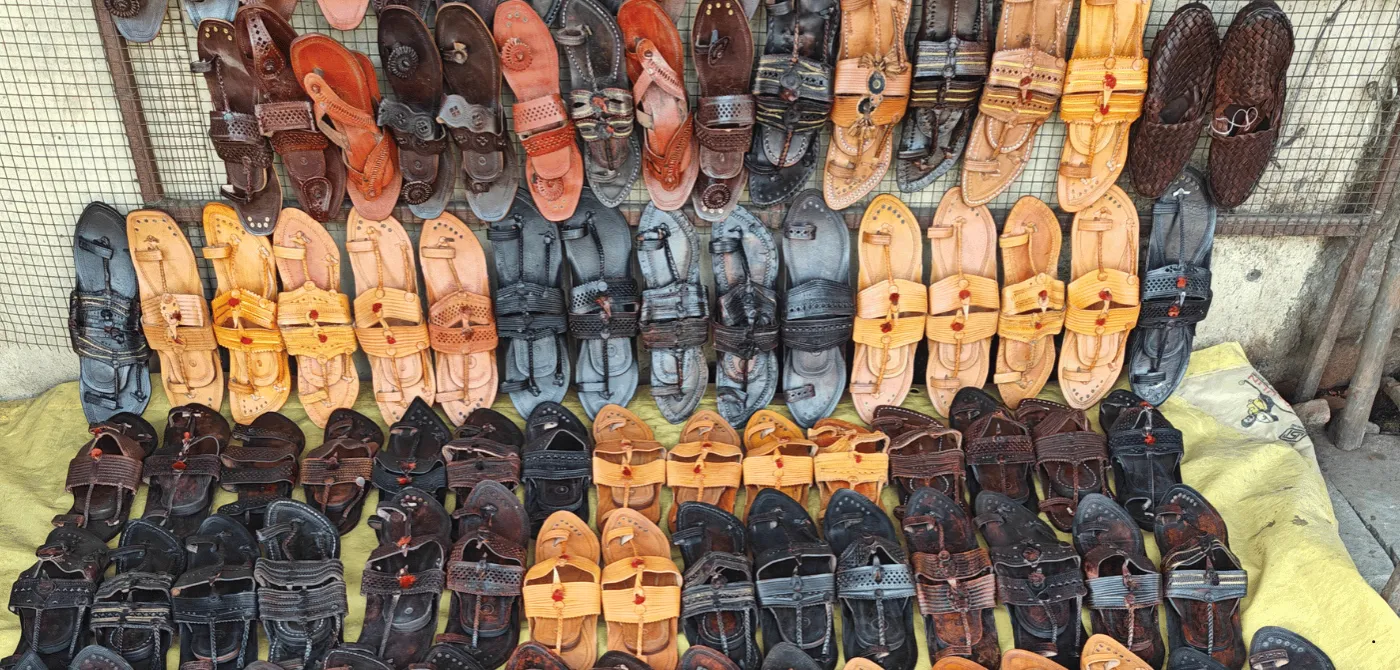When Prada recently unveiled a pair of sandals that closely resembled the Kolhapuri chappal, it triggered a wave of disapproval across India. Though often sold at modest prices locally, these chappals are a result of multi-generational craftsmanship. This is in stark contrast to the exorbitant prices fetched by luxury brands like Prada, exposing a troubling undervaluation of traditional artisanship.
The charge of cultural appropriation against Prada’s sandal is not just valid—it is self-evident. But the issue goes deeper than a West-versus-India framing. Within India too, the Kolhapuri chappal has long been shaped by caste hierarchies—where the beauty of the thing is embraced and the maker is marginalised.
Leatherwork, historically assigned to lower caste communities, has powered this craft for generations. Yet, from luxury brands profiting off the design to the caste-based assignment of leatherwork to lower caste communities, the men and women who have actually made these chappals for generations remain invisible. The common thread, whether in Italy or in India, is appropriation—the detachment of the product from the generations of work, effort, and knowledge of the people responsible for it.
This moment forces us to ask two legal questions about appropriation and its ubiquity.
First, why do existing laws fail to protect against appropriation, especially when these designs are widely used (and abused at times) to represent India on an international stage? And, second, if the law cannot respond even when the labour and knowledge of artisans are stripped of attribution and illegally commercialised by others, what does that say about whom the law sees and who it chooses not to?
Traditional designs are created and developed collectively. They do not have an individual creator. Their beauty lies not in their novelty, but in their continuity.
The unfortunate answer to the first question is that the law as it stands today does nothing.
The Designs Act, 2000 protects only designs that are “original” and are registered under the regime. But traditional crafts like the Kolhapuri chappal, shaped over generations and community held, rarely qualify.
Part of the problem lies in the law’s emphasis on “novelty” and “originality”. Traditional designs are created and developed collectively. They do not have an individual creator. Their beauty lies not in their novelty, but in their continuity.
However, the Designs Act is based on assumptions from the industrial era, which treat the depth and continuity of traditional designs not as valuable qualities, but as obstacles to legal protection. In other words, the law was created—primarily to serve capitalist goals—by granting short-term monopolies to individual creators in order to encourage innovation. But that logic sits uneasily with how traditional arts survive, adapt, and thrive—collectively, iteratively, and across generations.
Under the current legal framework, if a chappal design has existed in the public domain or has been replicated for generations, it cannot be registered. The artisans, therefore, have no design right to enforce—even against luxury brands that borrow freely from their work. Artisans do not have any basic right of attribution either.
Ironically, Prada may still be able to register its version by making minor tweaks to the design—mainly because here the creator is identifiable, individual, and able to establish just enough novelty to beat the system. All without ever disclosing the indigenous origins of the idea.
The Kolhapuri chappal design was never registered under the Designs Act—nor is it likely to be, owing to the legal emphasis on novelty and individual authorship, both of which fundamentally conflict with the collective, community-owned knowledge systems through which such crafts are sustained. This is the fate of most traditional arts in India today.
Another possible law that might offer protection is the copyright law. Yet, even the limited protection offered under the copyright law is quickly stripped away. India’s Copyright Act, 1957, although meant to protect a range of artistic endeavours, includes what is known as the “more-than-50” rule. Once an artistic design is reproduced more than 50 times by an industrial process, it loses copyright protection unless it has also been registered under the Designs Act (in which case the design protection continues).
For traditional artisans, this creates a legal trap—the very act of replication strips them of rights to protect their knowledge.
Some might look to India’s Geographical Indications (GI) law as an alternative form of protection, and, indeed, the Kolhapuri chappal is GI-registered. But that has proved of little use here. GI protects 'Kolhapuri' as a source identifier, meaning that only chappals made in designated districts by authorised producers can use the name. It neither protects against the design being copied nor recognises the knowledge embodied in the maker.
For traditional artisans, this creates a legal trap—the very act of replication strips them of rights to protect their knowledge. Once a traditional design begins to be widely produced and sold, the law treats it as belonging to no one, leaving it without legal protection. And yet, replication is often the only means of survival artisans have—they sell what they know how to make, again and again, to earn a livelihood.
In effect, Indian law does not just fail to protect traditional designs and artistic endeavours, it also puts them in a legal vacuum. What it excludes is precisely what most communities embody—collective creation, generational continuity, and inherited skills and knowledge shaped both by caste and labour.
For these reasons, in the Prada case, while the cultural appropriation may be obvious, the legal infraction is difficult to establish. Prada, careful to avoid direct legal exposure, neither described the sandals as 'Kolhapuri' nor reproduced any specific design or artwork in a manner that Indian law currently prohibits.
After facing intense backlash for its actions, Prada publicly acknowledged the Indian inspiration and opened a dialogue with the Maharashtra Chamber of Commerce, which represents artisans. The company has since committed to launching a limited-edition 'Made in India' sandal collection in collaboration with local artisan clusters.
But Prada is not an outlier. Across India, countless chappals that closely resemble Kolhapuris are marketed and sold without attribution to the original communities who have sustained the craft.
This is not a legal grey area, but a vacuum created historically in our legal system. It is an inevitable result of a legal framework that neither recognises collective knowledge nor protects the communities that sustain it.
The deeper issue is not about protection that is lacking in the law. It is about recognition—recognising knowledge, recognising the maker, and recognising the value created. And this brings us to the second question—when the embodied knowledge and labour of artisans are erased, what does the law have to say?
These laws are not designed to see the knowledge that is collective, iterative, and shaped by the labour and collective memory of its makers.
The Kolhapuri chappal, with its braided straps, natural dyes, and open-toe form, is not just a good-looking object, it is a repository of knowledge. The knowledge of how to work leather and natural dyes, of how to cut, braid, and assemble each piece with precision. It is a craft. It is also material knowledge—about how temperature affects the leather, how the texture impacts the output, and how the timing affects what can be done with the leather.
It is not written down or standardised as if it is a science. But that does not mean it is less valuable. More painstakingly still, it is knowledge held in the hands, muscles, and memory of the maker—passed down and perfected over generations.
Yet, Indian law has almost nothing to say about this kind of knowledge. It offers no language to recognise it, no mechanism to protect it, and no acknowledgement of the people who sustain it. When artisans’ expertise is reduced to a mere marketable “look”, the law does not even see this as a form of erasure—it simply treats it as irrelevant.
This erasure is not incidental; it is systemic. At its core, intellectual property is a product of capitalist logic. It is designed to maximise profit and incentivise innovation—assumptions that only make sense in a world where creativity is individual, industrial, and commodifiable. These laws are not designed to see the knowledge that is collective, iterative, and shaped by the labour and collective memory of its makers. The law struggles to recognise this because this form of making and holding does not conform to the industrial narrative that has shaped the law.
When such a system meets a product like the Kolhapuri chappal, the result is predictable—it either excludes the knowledge altogether or asks the community to fit itself into forms it was never intended to inhabit. In effect, the law treats traditional artisans as legal outsiders to their own creation. And Kolhapuris are not alone. From rich thread-based crafts like Lambani and Zardozi to Madhubani and Warli motifs in luxury decor, traditional crafts are routinely extracted from their communities and repackaged (mostly by luxury brands) without recognition or return.
This is not just a failure of the law. It reflects a deeper discomfort in Indian legal thinking—a reluctance to treat non-institutional knowledge, memory, and collectively held culture as legally significant.
This idea of the value of the tacit, embodied knowledge held by artisans is being explored by researchers like Annapurna Mamidipudi and Dagmar Schäfer, who examine how such knowledge challenges conventional notions of ownership and innovation. “Artisanal knowledge is owned not just as property but also as culture, ritual, and secret,” Mamidipudi says. 1Mamidipudi, Annapurna (2023): “Latest Thinking, What Can Artisanal Production Teach Us about Knowledge and Ownership?”, Max Planck Institute for the History of Science. https://doi.org/10.21036/LTPUB101053 She argues that this knowledge is material and embodied, and inseparable from craft itself, and its performance and use must be recognised as a central component of ownership and value in any ethical or legal framework.
Knowledge that is embodied, inherited, and sustained in caste-bound labour has never fit easily into legal categories—but that does not make it any less real.
Some countries have begun to take steps towards recognising and protecting such community-held knowledge. For instance, New Zealand has developed legal mechanisms to safeguard Māori traditional knowledge and designs, offering a potentially inclusive model. However, these frameworks are still evolving and are yet to be meaningfully tested over time.
In a country where artisans preserve and pass down centuries of material and cultural knowledge—recognised as intangible heritage—the legal system cannot afford to be so disconnected from their realities. Perhaps the question is not just whether the law can protect this kind of knowledge, but whether it can learn to see it in the first place.
Knowledge that is embodied, inherited, and sustained in caste-bound labour has never fit easily into legal categories—but that does not make it any less real. The law may not yet have the tools to recognise it, but maybe the first step is to acknowledge that something vital has been overlooked. And to ask, urgently, what must change for the law to see what it has refused to for so long.
No one is arguing for unfettered monopolies. However, in a world where a brand like Prada can copy a local artisan’s design and even obtain legal protection for it, while the same artisan could face a lawsuit for copying Prada, something is clearly broken in the system.
Sheetal Srikanth is a lawyer practising in Hyderabad.









